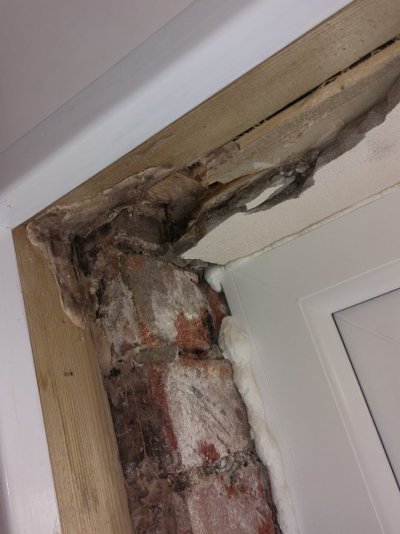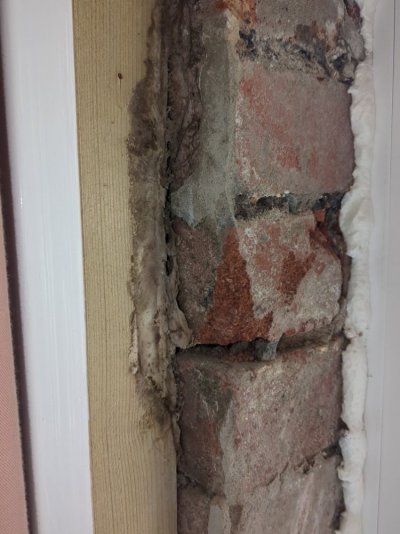You are using an out of date browser. It may not display this or other websites correctly.
You should upgrade or use an alternative browser.
You should upgrade or use an alternative browser.
Dry rot identification help
- Thread starter bd000
- Start date
Cubist
Member
- Messages
- 3,295
- Location
- Shropshire/Herefordshire Border
Matt Green is the acknowledged expert on the topic amongst the members here and I'm sure he would have commented had he seen your post before now - unfortunately the frequency of new additions to the topics list can push your input 'out of sight' quite quickly at times so its likely he just hasn't seen it.
I'm far from being an expert but to my eye this could be either Dry or Wet Rot but both are treatable once properly identified. In the meantime leave these areas exposed to monitor for nearby sources of moisture near the damaged areas and to let the atmosphere dry them out.
Hopefully Matt will be along soon to provide better advice and guidance.
I'm far from being an expert but to my eye this could be either Dry or Wet Rot but both are treatable once properly identified. In the meantime leave these areas exposed to monitor for nearby sources of moisture near the damaged areas and to let the atmosphere dry them out.
Hopefully Matt will be along soon to provide better advice and guidance.
Thank you, very kind of you!
I did some YouTube "research" and came away thinking that it should be enough to do the following:
Or what do people think?
Cheers
I did some YouTube "research" and came away thinking that it should be enough to do the following:
- ensure that no more water comes in,
- let the area dry out (possibly by taking off some of the surrounding dry wall),
- replace whatever has lost its structural integrity,
- put back the dry wall.
Or what do people think?
Cheers
Cubist
Member
- Messages
- 3,295
- Location
- Shropshire/Herefordshire Border
The only good reason for using an anti-fungal treatment is the hope that it kills off both the extant infection AND the spores it has already produced that may infect a larger area. The golden rule to keep in mind is that what you can see today may be only 10% of the problem - Dry/Wet Rot, like woodworm, is a bit like an iceberg in that regard.
Matt Green
Member
- Messages
- 718
Morning, yes that does look like dry rot.
This advice is fine...
It looks like a uPVC door has been put in, badly, and the lintel(s) looks very suspect indeed. It looks like untreated pine and if it has got wet enough for a dry rot spore to germinate then there is a lot of water getting into that cavity over the door.
I would be inclined to remove the door, remove any timbers in there, work out how the water is getting in and stop it, replace with treated timber of good quality and isolate it from the surrounding masonry. Following that, leave the plaster off from the reveal as long as you can tolerate whilst the area dries down.
M.
This advice is fine...
- ensure that no more water comes in
- let the area dry out (possibly by taking off some of the surrounding <plaster>),
- replace whatever has lost its structural integrity,
- put back the <plaster>Dry wall being plasterboard in American English
It looks like a uPVC door has been put in, badly, and the lintel(s) looks very suspect indeed. It looks like untreated pine and if it has got wet enough for a dry rot spore to germinate then there is a lot of water getting into that cavity over the door.
I would be inclined to remove the door, remove any timbers in there, work out how the water is getting in and stop it, replace with treated timber of good quality and isolate it from the surrounding masonry. Following that, leave the plaster off from the reveal as long as you can tolerate whilst the area dries down.
M.
Thanks for your comment and insight.
Yes, we had a new uPVC door put in. It was moved further out, the old door was leaking (at the bottom) and sitting on the now exposed timers (with the fungus).
Yes, the area over the door does not look great and also needs sorting out. I would not want to take off more of the render at the bottom of it, as the new door is installed against that. So I though maybe take of the vertical bit drywall which closes off the cavity towards the inside of the room, so we can fix it from there while keeping the bottom as it is.
What else makes you think that the door was put in badly?
Yes, we had a new uPVC door put in. It was moved further out, the old door was leaking (at the bottom) and sitting on the now exposed timers (with the fungus).
Yes, the area over the door does not look great and also needs sorting out. I would not want to take off more of the render at the bottom of it, as the new door is installed against that. So I though maybe take of the vertical bit drywall which closes off the cavity towards the inside of the room, so we can fix it from there while keeping the bottom as it is.
What else makes you think that the door was put in badly?
Matt Green
Member
- Messages
- 718
What else makes you think that the door was put in badly?
The quality of the lintel looks a bit rough.
Matt Green
Member
- Messages
- 718
What are your thoughts on the general worry that the bit of "dry rot" we see is just the tip of the iceberg and therefore we need a much more radical approach?
Dry rot needs a lot of fresh water and cheap untreated timber to really get going. Until you work out how that timber got wet I wouldn't waste any time worrying about anything else. To be fair you already removing the door and removing and replacing the surrounding timbers- how much more radical were you hoping for?
Bear in mind that by doing just that you are doing more damage to the building fabric than the rot has achieved- it's just that had the work been undertaken using decent materials the first time you wouldn't be in this situation. The fact that you have dry rot is pretty irrelevant- you have a badly fitted door and that's the cause of your issue.
Last edited:
Matt Green
Member
- Messages
- 718
Take away the timber and there will be nothing for the fungus to feed on. By all means surface treat the exposed masonry with a commercial fungicide if you feel it will help you sleep but I would not suggest any opening up works specifically to apply a fungicide to an inorganic substrate.


